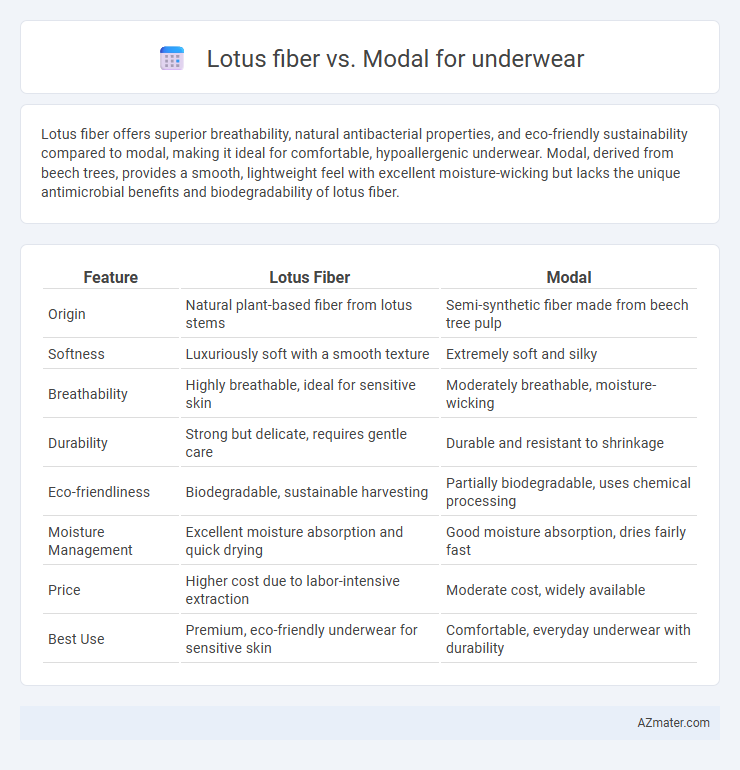Lotus fiber offers superior breathability, natural antibacterial properties, and eco-friendly sustainability compared to modal, making it ideal for comfortable, hypoallergenic underwear. Modal, derived from beech trees, provides a smooth, lightweight feel with excellent moisture-wicking but lacks the unique antimicrobial benefits and biodegradability of lotus fiber.
Table of Comparison
| Feature | Lotus Fiber | Modal |
|---|---|---|
| Origin | Natural plant-based fiber from lotus stems | Semi-synthetic fiber made from beech tree pulp |
| Softness | Luxuriously soft with a smooth texture | Extremely soft and silky |
| Breathability | Highly breathable, ideal for sensitive skin | Moderately breathable, moisture-wicking |
| Durability | Strong but delicate, requires gentle care | Durable and resistant to shrinkage |
| Eco-friendliness | Biodegradable, sustainable harvesting | Partially biodegradable, uses chemical processing |
| Moisture Management | Excellent moisture absorption and quick drying | Good moisture absorption, dries fairly fast |
| Price | Higher cost due to labor-intensive extraction | Moderate cost, widely available |
| Best Use | Premium, eco-friendly underwear for sensitive skin | Comfortable, everyday underwear with durability |
Introduction to Lotus Fiber and Modal
Lotus fiber, derived from the stems of lotus plants, is a natural, biodegradable textile known for its softness, breathability, and moisture-wicking properties, making it ideal for comfortable underwear. Modal, a semi-synthetic fiber made from beech tree pulp, offers excellent durability, smoothness, and high absorbency, providing a silky feel and long-lasting comfort in intimate apparel. Both fibers emphasize eco-friendliness and comfort, with lotus fiber being more rare and sustainable, while modal benefits from mass production and enhanced strength.
Origins and Production Processes
Lotus fiber is derived from the stems of lotus plants, harvested mainly in Southeast Asia through a labor-intensive, sustainable extraction process that involves soaking, crushing, and hand-weaving the fibers into fabric. Modal originates from beechwood pulp, processed using a chemically intensive yet environmentally improved method called the viscose process, which enhances absorbency and softness. The natural, eco-friendly production of lotus fiber contrasts with the semi-synthetic Modal, reflecting distinct ecological footprints and fabric characteristics in underwear manufacturing.
Environmental Impact
Lotus fiber underwear offers superior environmental sustainability compared to Modal, as it is derived from the naturally renewable lotus plant without the need for harmful chemicals or intensive water use. Modal production relies heavily on beech trees and involves chemical-intensive processes that contribute to water pollution and higher carbon emissions. Choosing lotus fiber reduces deforestation and lowers water consumption, making it a more eco-friendly choice for sustainable underwear.
Comfort and Breathability
Lotus fiber offers exceptional breathability and natural moisture-wicking properties, making it ideal for underwear that stays cool and dry throughout the day. Modal, derived from beech tree pulp, provides a silky softness and excellent stretch, enhancing comfort and fit. Both fibers promote superior comfort, but lotus fiber excels in airflow and temperature regulation.
Moisture-Wicking and Odor Control
Lotus fiber offers superior moisture-wicking properties due to its natural hollow structure, which allows for enhanced breathability and quick drying, making it ideal for underwear. Modal, derived from beech tree pulp, also provides effective moisture management but tends to retain less odor resistance compared to lotus fiber. The antibacterial qualities of lotus fiber contribute to better odor control, ensuring prolonged freshness in intimate apparel.
Durability and Lifespan
Lotus fiber offers exceptional durability due to its natural strength and resistance to wear, making it ideal for long-lasting underwear. Modal fabric, while soft and breathable, tends to have a shorter lifespan as it can weaken over time with repeated washing. Choosing lotus fiber ensures underwear retains shape and durability, outperforming modal in longevity.
Skin Sensitivity and Hypoallergenic Properties
Lotus fiber, derived from the lotus plant, offers natural hypoallergenic properties ideal for sensitive skin, minimizing irritation and allergic reactions in underwear. Modal, a semi-synthetic fabric made from beech tree pulp, is breathable and soft but may cause sensitivity issues in individuals prone to allergies due to its chemical processing. Choosing lotus fiber underwear enhances comfort for those with delicate skin by reducing exposure to synthetic chemicals and allergens commonly found in modal fabric.
Stretch and Fit for Underwear
Lotus fiber offers moderate stretch with excellent breathability, making it ideal for underwear requiring natural comfort and a relaxed fit. Modal provides superior stretch and shape retention due to its synthetic cellulose base, ensuring snugness and long-lasting elasticity in close-fitting underwear. Combining these fibers can optimize both stretch and fit, enhancing overall comfort and durability.
Care and Maintenance Requirements
Lotus fiber underwear demands gentle care with hand washing or cold machine cycles to preserve its natural softness and durability, avoiding bleach and harsh detergents that can damage fibers. Modal underwear offers easier maintenance, as it withstands regular machine washing and drying with minimal shrinking or color fading, thanks to its semi-synthetic, cellulose-based origin. Both fabrics benefit from air drying and low heat ironing to extend garment lifespan and maintain fabric integrity.
Price Comparison and Accessibility
Lotus fiber underwear typically costs more due to the labor-intensive extraction process and limited production, making it less accessible in mainstream markets. Modal fabric offers a more budget-friendly option with widespread availability in various retail outlets and online stores. Consumers seeking affordable, easily accessible underwear often prefer Modal over the premium-priced Lotus fiber alternatives.

Infographic: Lotus fiber vs Modal for Underwear
 azmater.com
azmater.com